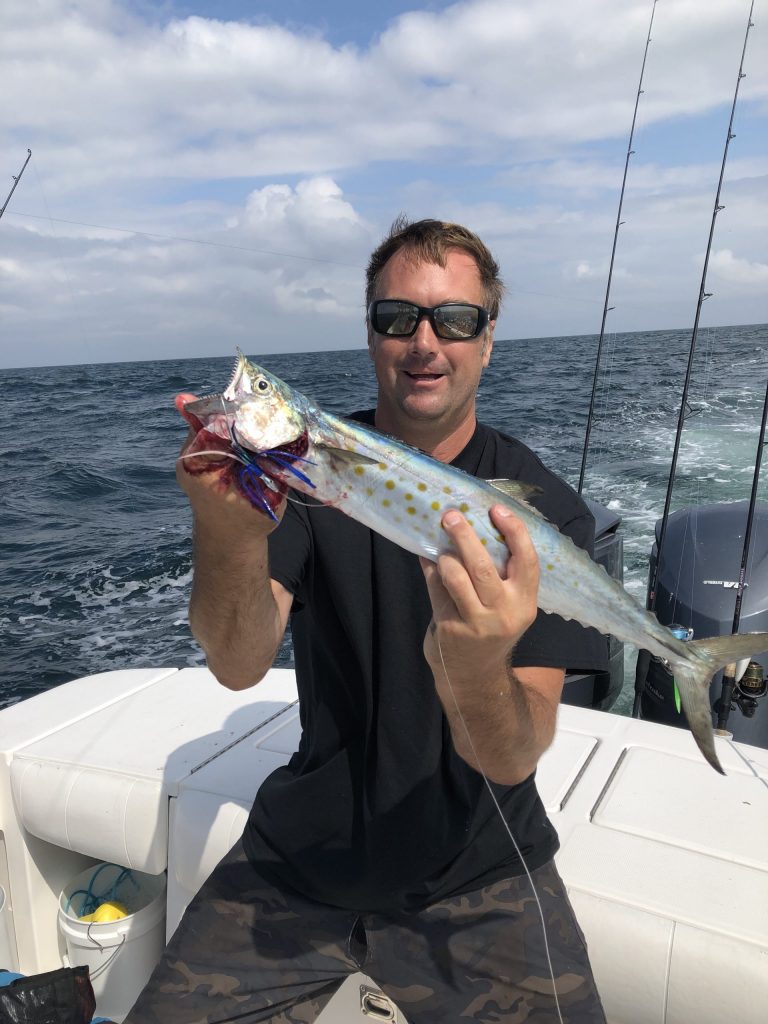
Strangely enough, it seems that everything has been a little behind schedule for the first wave of summer in that water temps in early July were still hovering between 58 and 65 degrees on any given day. That gave a kind of slow start to the fluke fishing which should have been running hard by early July well into the 70’s. With sweltering temperatures predicted for most of July and into August, everything should be back up to speed with speedsters like albies and mackerel, mahi on the pots, bluefin and yellowfin tuna as well as fluke and sea bass. Regulation wise, blackfish season reopens again from August 1 to November 15 with a one fish limit at 15-inch minimum size and black sea bass season is still open through August 31st with 2 fish at 12.5 inches.

RARITAN BAY
The Keansburg and Belford pier areas were hot spots for fluking all through July. Some serious caliber fluke up to 7 pounds were taken on a regular basis. The tip of Sandy Hook was also a prime spot to intercept fluke as anglers were floating live killies out on bobbers to score with doormat caliber fish. Those flatfish should really be on the chew now in Raritan Bay. Try areas like the deeper channel at Chapel Hill Channel, off the Ammo Pier, Ambrose Channel and Swash Channel to find flatfish sticking down to the depths. My bet would be to send down 1 to 2 ounce bucktails tipped with fluke belly if fishing at Chapel Hill or Ammo Pier inside the bay, then switch up to a fishfinder slide rig with a live snapper blue or long stirp bait if working the mouth of Raritan at Romer Shoal or Ambrose Channel as the currents rip a bit harder through there. Bluefish were still running around the bay waters in July with average catches from 3 to 10 pounds and the choppers may still be hanging around in August.
NORTHERN COAST
Ling fishing continued to dominate the central coast area structure piles with both night and day trips putting up double digit catches of ling per man, sometimes up to 30. Simple clam bit baits on the bottom hung ling, and most were of formidable size in the 1 to 3 pound bracket. Spots like the Shark river Reef and Mohawk area were holding plenty of ling, but also will be spots to drop down on for sea bass with the season reopened now. Heading out to the Mud Hole area wrecks in the 10 to 15 mile range, the addition of winter flounder and progies to the mix will spice things up. Fluke fishing should be sticking tight to the Elberon Rocks, Shrewsbury Rocks and the Long Branch lumps in the 50 to 70 foot range. Drag strip baits, spearing and sand eels to hook into fluke there or work a bucktail if you have a spot lock trolling motor to keep you over a structure pile. The low lying rubble on the Sandy Hook Reef or Elberon rocks are prime time turf to work bucktails for large doormat caliber fluke over 10 pounds. Night bluefish trips will also be running to the ledges of the Mud Hole to chum of fish, which have recently been averaging in the 3 to 5 pound class, with occasional choppers hitting the 12-pound mark. Jetty jumpers will be looking to send out small metals off the jetty tips to reach the albie and bonito schools if they show up.
CENTRAL COAST
Fluke fishing got off to a slow start but should be primed right now especially at the nearshore reefs of Manasquan Reef, Sea Girt Reef and Axel Carlson reef sites. I like the southeast side of the Axel Carlson reef for fluke as it offer plenty of low lying structure like army tanks and tire units which fluke love to sit between and ambush prey. There will also be enough sea bass to fill your two fish limit on at that spot. On those reef sites, be on the lookout for the lobster pot hi-flier flags, which should be holding some small mahimahi to the ropes. Creep up on the flags and toss a small ¾-ounce to 1-ounce bucktail tipped with a Berkeley Gulp! Swimming minnow and tease up any mahi hanging around, if you do happen to hook a mahi, keep it in the water as scores of other mahi will become frenzied and then you can pick off dozens at a time. If you don’t get any hits after a couple of passes on the hi-flier move to another one and work it over. You can also opt to troll around the reef sites with small feathers and 00 Clark spoons setting out 6 rods to hook into Spanish macks, bonito, albies and mahi as well. Bump on out to the Manasquan Ridge too, about five miles off, as it’s usually a hotbed for speedsters.
OFFSHORE
Thankfully, bluefin tuna have not let up at all offshore, in fact, they have even moved further inshore this year. Anglers trolling around the Mud Hole area and inside the Chicken Canyon have been hanging football bluefin as well as small to medium class fish up to 60 pounds there, but if you want to target larger BFT, head on out to the Triple Wrecks, Resor Wreck Winnecone and Texas Tower to find the 60 to 100-ound class BFT. Yellowfin tuna have been off to a good start to inside the West Wall of the Hudson Canyon as trollers dragging sidetracker spreaders and squid bars are finding 60 pound class YFT. The jig and pop bite is just getting started too. Keep your eyes out for obvious signs of birdplays as well as whales, turtle and porpoises in the area. Mark the fish in the finder and work the proper offerings according to their depths. Generally the pop bite gets better during the day after about 1 PM, but when the mass amount of boats are out there, switch up to jigging the fish as the traffic pushes the fish down in the water column around 100 to 150 feet. Be sure to have the proper gear to battle these fish and don’t go undergunned. Bring 7 to 8 foot sturdy 50 to 80-pound rated spinning and jigging rods with 65 to 80-pound braided line and 80 to 100-pound fluorocarbon top shot leaders.
It’s shaping up to be a great August fishing both inshore and offshore for a variety of species. For tuna, be sure to check the NOAA website for up to date regulations as they can literally change by the hour. Enjoy the dog days of summer and put some fish on the grill!
